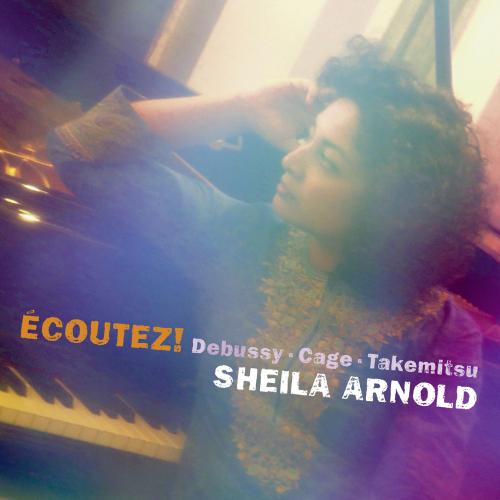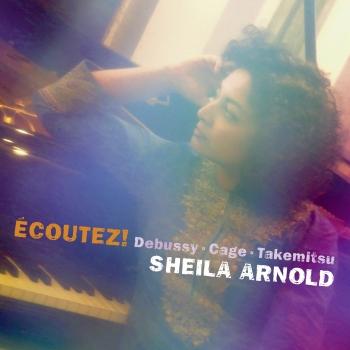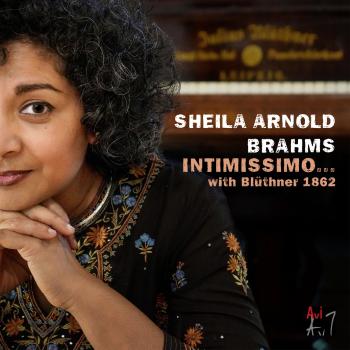
ECOUTEZ! Debussy, Cage & Takemitsu Sheila Arnold
Album info
Album-Release:
2018
HRA-Release:
15.05.2018
Label: CAvi-music
Genre: Classical
Subgenre: Instrumental
Artist: Sheila Arnold
Composer: Claude Debussy (1862-1918), John Cage (1912-1992), Toru Takemitsu (1930-1996)
Album including Album cover Booklet (PDF)
I`m sorry!
Dear HIGHRESAUDIO Visitor,
due to territorial constraints and also different releases dates in each country you currently can`t purchase this album. We are updating our release dates twice a week. So, please feel free to check from time-to-time, if the album is available for your country.
We suggest, that you bookmark the album and use our Short List function.
Thank you for your understanding and patience.
Yours sincerely, HIGHRESAUDIO
- Claude Debussy (1862-1918):
- 1 Images, Book I, L. 110: No. 1. Reflets dans l'eau 06:29
- 2 Images, Book I, L. 110: No. 2. Hommage à Rameau 07:05
- 3 Images, Book I, L. 110: No. 3. Movement 03:18
- Toru Takemitsu (1930-1996):
- 4 Piano Distance 05:22
- Claude Debussy:
- 5 Preludes, Book II, L. 123: Les Fées sont exquisies danseuses 03:41
- John Cage (1912-1992):
- 6 Sonatas and Interludes for Prepared Piano: Sonata VIII 03:10
- 7 Sonatas and Interludes for Prepared Piano: Sonata II 02:06
- 8 Sonatas and Interludes for Prepared Piano: Sonata VI 02:22
- 9 Sonatas and Interludes for Prepared Piano: Sonata VII 02:52
- 10 Sonatas and Interludes for Prepared Piano: Sonata V 01:41
- Toru Takemitsu:
- 11 La Pause Ininterrompue: No. 1. Quietly and with a cruel reverberation 03:45
- Claude Debussy:
- 12 Préludes, Book I, L. 117: No. 1. Danseuses de Delphes 03:11
- 13 Préludes, Book I, L. 117: No. 2. Voiles 04:04
- 14 Préludes, Book I, L. 117: No. 3. Le Vent das la plaine 02:12
- Toru Takemitsu:
- 15 La Pause Ininterrompue: No. 2. Slowly, sadly and as if to converse me 02:17
- Claude Debussy:
- 16 Préludes, Book I, L. 117: No. 7. Ce qu'a vu le vent d'Ouest 03:38
- 17 Preludes, Book II, L. 123: No. 10. Canope 03:15
- Toru Takemitsu:
- 18 La Pause Ininterrompue: No. 3. A song of love 01:20
- John Cage:
- 19 Sonatas and Interludes for Prepared Piano: Third Interlude 03:01
- Claude Debussy:
- 20 Preludes, Book II, L. 123: No. 12 Feux d'artifice 05:06
Info for ECOUTEZ! Debussy, Cage & Takemitsu
Claude Debussy left a profound mark on music history when he dissolved functional harmony under the influence of the music of the Far East.
Tōru Takemitsu had to distance himself from his own culture in order to listen to Japanese music with the ears of a Western-trained musician – adopting, for instance, the approach of John Cage. He came to realize that Japan’s venerable musical tradition had long been highlighting individual notes as complex sonorities in their own right, instead of treating them as part of a series of several notes.
From the human need for sound as well as silence, John Cage drew the most extreme conclusions. The concept of a “beautiful” sound was never static in music history: it has changed over the centuries, and it differs from one culture to another. Western musical aesthetics tend to differentiate between “noises” and “notes”: the latter feature well-ordered harmonics. The concept of “dissonance” has also changed throughout different musical periods. What is more, musicians and their audiences have always felt the need to “savor” a dissonance – to listen to it consciously, to experience it – before it is resolved.
On the other hand, time plays a truly fundamental role in how a work is conceived and structured, and each individual listener experiences musical time in a different way. Ideally, the performer and the listener share the same time system: they enjoy passages in a similar way, they hear a piece with the same depth of focus. Music resonates inside the instrument, in our bodies, in the space that surrounds us. Each note is in motion. When several notes vibrate simultaneously, they make up an ocean of concomitant vibrations. If we add the sounds and noises from our surroundings, then we are dealing with an incredible concentration of sonic events within a very short period of time.
What happens then?
We become more aware of the way we perceive things. If we are lucky, this kind of conscious musical listening starts to affect how we pay attention to other people, whether they are speaking or not. And lending an ear to one another has become more necessary than ever. Wouldn’t you agree? (Sheila Arnold)
Sheila Arnold, piano
Sheila Arnold
worldwide concert career was launched with outstanding successes at international competitions (the Salzburg Mozart Competition and the Concours Clara Haskil) as well as many scholarships and awards, including the Wiesbaden Mozart Society's Mozart Prize (1995). She has played in many of the great concert halls of Europe, including the Bregenz Festival Hall, the Concertgebouw in Amsterdam, the Palau de la Música in Valencia, the Berlin Philharmonie, the Hamburg Music Hall, the Leipzig Gewandhaus, the Stuttgart Liederhalle and the Dortmund Konzerthaus. She has also toured the Near and Far East and the United States.
Sheila Arnold has been invited to perform at many international festivals and has played with leading orchestras such as the Orchestre de Chambre de Lausanne, the Orchestre de Chambre de Genève, the Beethoven Halle Orchestra in Bonn and the Prague Chamber Orchestra. Conductors with whom she has performed with include Jesús López-Cobos, Marc Soustrot, Heribert Beissel, Kenneth Montgomery and Michael Hofstetter. Enthusiastic reviews from the international press confirm her status as an unusually versatile musician.
Sheila was born in Tiruchiralpalli in Southern India and grew up in Germany. Her teachers were Heidi Köhler and Karl-Heinz Kämmerling. She also drew her ideas from inspiring encounters with the pianists such as Imogen Cooper, Elisabeth Leonskaja, Ference Rados and Lev Naumov.
Chambermusic activities with violinist Latica Honda-Rosenberg, Isabelle Faust, clarinet player Nina Janssen und Ralph Manno, bassoon player Sergio Azzolini, Horn player Wilhelm Bruns, cellist Guido Schiefen, actor Bernt Hahn or guitarist Alexander-Sergei Ramirez mean inspiration to her on the musical as well as on the personal level.
Sheila’s interest in period keyboard instruments, especially in fortepianos of the 1790’s up to the present times, has been a special and constant source of inspiration. Apart from performances on the modern concert grand she can often be heard on the fortepiano in various chamber musc constellations, in recitals and as a soloist with chamber orchestras. She has been „Artist in Residence“ Kempen in 2006. She has a longstanding duo with classical guitarist Alexander-Sergei Ramírez.
Her CD- and radio productions demonstrate her huge variety in repertoire ranging from baroque music through Haydn, Mozart, Brahms, Granados and Scriabin,up to first performances of contemporary music.
The latest two CD releases include works by J. Brahms and Clara Schumann as well as a programe for music and literature with actor Bernt Hahn on Robert Schumann and the poets of the romantic period.
In 2005 Sheila gave birth to a wonderful daughter.
In 2006 she received a professorship at the Musikhochschule Cologne. She also gives masterclasses at Schloß Engers in Neuwied (Landesmusikakademie Rheinland-Pfalz), Emsbürener Musiktage, Schloß Hammelburg (Bayrischer Tonkünstlerverband), Bombay (Sangat-Festival) and workshops in different European countries.
Booklet for ECOUTEZ! Debussy, Cage & Takemitsu













